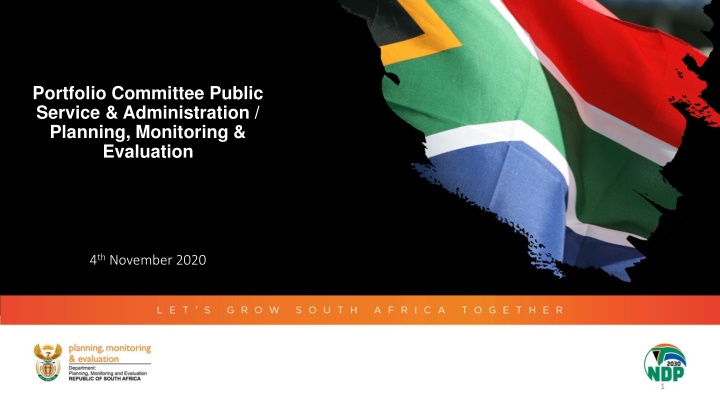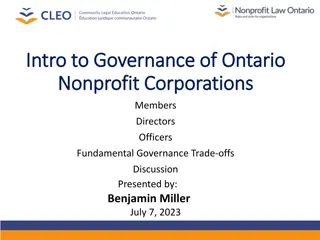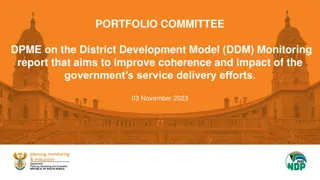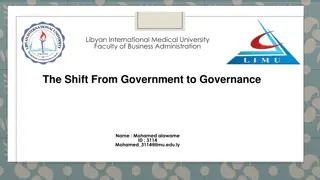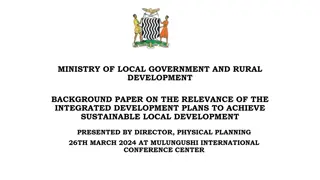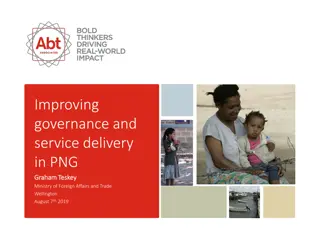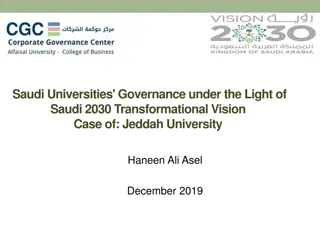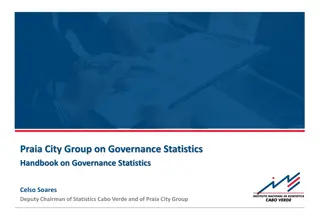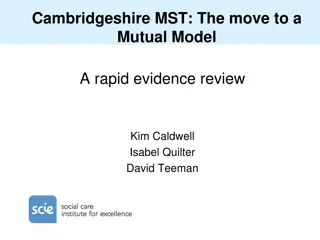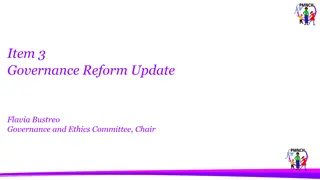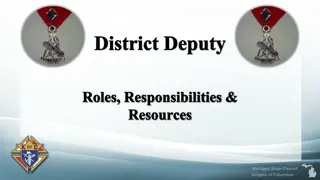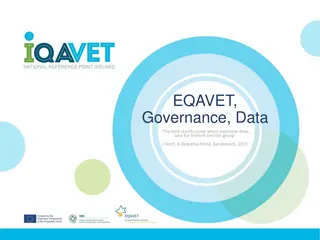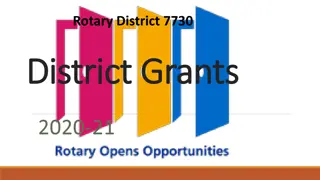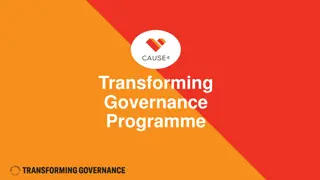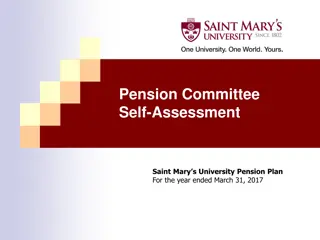District Development Model (DDM): Enhancing Governance and Service Delivery
Explore the District Development Model (DDM) and its implementation in the Harry Gwala District, KZN. This operational framework aims to enhance cooperative governance, improve service delivery, and build a capable, ethical Developmental State. Learn about the Medium-Term Strategic Framework (MTSF), principles of the DDM, COVID-19 response, and the role of the Department of Planning, Monitoring, and Evaluation (DPME) in driving progress. Discover how the DDM enables collaboration across government spheres and development partners to achieve impactful outcomes in 52 districts and metropolitan areas.
Download Presentation

Please find below an Image/Link to download the presentation.
The content on the website is provided AS IS for your information and personal use only. It may not be sold, licensed, or shared on other websites without obtaining consent from the author.If you encounter any issues during the download, it is possible that the publisher has removed the file from their server.
You are allowed to download the files provided on this website for personal or commercial use, subject to the condition that they are used lawfully. All files are the property of their respective owners.
The content on the website is provided AS IS for your information and personal use only. It may not be sold, licensed, or shared on other websites without obtaining consent from the author.
E N D
Presentation Transcript
Portfolio Committee Public Service & Administration / Planning, Monitoring & Evaluation 4thNovember 2020 1
CONTENT Purpose of the Presentation Background What is the District Development Model (DDM)? The Medium Term Strategic Framework (MTSF) Cascading the MTSF to district level What does the DDM enable? The Principles of the DDM and the COVID-19 response DPME role in the DDM and progress made Harry Gwala District, KZN: A case study of the DDM in action Recommendations Conclusion 1
PURPOSE OF PRESENTATION To Provide the Portfolio Committee Public Service and Administration / Planning, Monitoring & Evaluation: With a brief overview of the District Development Model. The role of DPME in the DDM and progress made. A case study of the DDM in Action: Harry Gwala District. 2
BACKGROUND The DDM was approved by Cabinet in August 2019 as an operational model for improving Cooperative Governance aimed at building a capable, ethical Developmental State. The DDM is championed by the President of the Republic of South Africa. The responsibility to manage the institutionalisation of the model with the cooperative governance system of the country is undertaken by the Minister for Cooperative Governance and Traditional Affairs (DCOGTA). 3
WHAT IS THE DISTRICT DEVELOPMENT MODEL? The DDM embodies an approach by which the three spheres of government and state entities work in unison with other development partners in an impact-oriented way and where there is higher performance and accountability for coherent service delivery and development outcomes. It influences spatialisation and reprioritisation of government planning, budgeting, implementation and reporting in relation to jointly agreed outcomes and commitments in the 52 districts and metropolitan spaces. This is facilitated through and anchored around the OnePlan , OneBudget , OneDistrict . 5
THE MTSF 2019-2024 1 2 3 4 5 6 7 A Capable, Ethical and Developmental State Building a capable state that serves all the people 5 Year Implementation of the NDP 2030 Governments Plan for the 6th Administration 7 National Priorities Consolidating the Social Wage through Reliable and Quality Basic Services Building a united and cohesive society NDP 2030 Economic Transformation and Job Creation Investment, jobs and inclusive growth Manifesto Spatial Integration, Human Settlements and Local Government An effective land reform programme Eradicating poverty and and improving people s lives Education, Skills and Health Education and skills for a changing world SONA 2019 Social Cohesion and Safe Communities Social cohesion and safe communities MTSF 2019-2024 A Better Africa and World Better Africa, better world 3
CASCADING THE MTSF 2019-2024 TO THE PROVINCIAL/ METRO/ DISTRICT LEVEL MTSF 2019-2024 IDPs MTSF 2019- 2024 Metro/ District 7 SPs and APPs National Priorities Provincial PGDS NSDF National PGDSs IDPs SPs and APPs Joined Up Plans Spatially Located in Provinces (9), Metros (8) and Districts (44) All of Government Geared to deliver on the 7 National Priorities National/ Province/ Metro/ District specific contribution to the 7 National Priorities 7
WHAT DOES THE DDM ENABLE? It resolves silo planning, budgeting and implementation that hinders cohesive service delivery and maximum developmental impact on peoples lives and socio-economic and spatial transformation. A more tangible common vision for the development of the country which is collectively generated in relation to the differentiated challenges, potentials and competitive advantages of the 52 district and metropolitan spaces (Intergovernmental Relations impact zones). Shift from alignment of planning to joint planning, with multi-year long term and predictable objectives, targets and resource commitments to achieve agreed outcomes extending beyond electoral cycle. A clearer and more measurable government and society wide spatial and integrated development accountability framework. Roots development within communities and brings government closer to the people. 4
THE PRINCIPLES OF THE DDM AND THE COVID-19 RESPONSE The principles of the DDM enabled government to implement a differentiated approach to COVID-19 and based on the lessons learnt will be further strengthened. A district approach was an advantage to strategically coordinated response to service delivery, development, and disaster management in the context of each districts specific circumstances. It allowed for spatial mapping of the Covid-19 outbreaks, health interventions, and health system readiness (ward profiles). The current intergovernmental structures established to coordinate the COVID-19 response will be repurposed and strengthened to support to support the DDM. A COVID-19 monitoring which includes gender based violence, is one of the tasks given to the Ministers and Deputy Ministers who have been deployed across the 52 IGR impact zones as district champions. This role has been included into the Performance Agreements of Ministers and Deputy Ministers for which DPME is responsible for. 4
THE ROLE OF DPME AND PROGRESS DPME supports a place-based implementation framework that aligns our national development goals within spaces, while also recognising that there are aspects of National and Regional Importance that will require an implementation approach that straddles multiple districts, but that the Inter-Governmental Relations Framework Act includes provisions that could be explored and used. DPME plays a central role in policy coordination, planning, monitoring and evaluation of the National Development Plan (NDP) and of its implementation through the MTSF. The DDM necessitates the localization of the Medium Term Strategic Framework (MTSF) to the districts in alignment to their specific development needs and challenges. A Steering Committee has been set up with DPME, DCOGTA and National Treasury for alignment of Government Planning and Budgeting Cycle and for steering national sector policy priorities, plans and budgets at district level through the spatialsation of departmental Strategic and Annual Performance Plans. Progress has been made on the geo-spatial mapping of projects at district level. Impact indicators for the localisation of the MTSF has been developed. 10
THE ROLE OF DPME: PROGRESS Monitoring of the implementation of the 3 pilot sites (Waterberg, OR Tambo and EThekwini) was limited due to restrictions in travel due to COVID-19. One of the COVID-19 monitoring projects of DPME, is Local Government and the DDM. Emerging findings is that communities whom have suffered spatial disadvantage have been exposed to vulnerabilities of the pandemic eg. particularly access to water, shelter, economic activity. DPME have been participants of DCOGTA processes in the 3 districts and having been engaging with Offices of the Premier in all provinces. DPME frontline monitoring unit does have 2 directors responsible for the monitoring of provinces, with a deputy director responsible for each province. A conceptualisation of an automated project management system within DPME is being explored. It would set the basis of the monitoring system of DPME from district to MTSF reporting biannually to Cabinet. The setting up of the National Research Observatory is being set up. Work has started on the development of District Evaluation Plans in order to measure impact. DPME has been supporting the Executive in the Harry Gwala and Sekhukhune district. This has allowed for building capability in the monitoring of the the DDM and as well as allowing for innovation. 11
HARRY GWALA DISTRICT, KWAZULU-NATAL: A CASESTUDY OF DDM IN PRACTICE 12
HARRY GWALA DISTRICT, KWAZULU-NATAL: A CASESTUDY OF DDM IN PRACTICE 13
TERMS OF REFERENCE FOR POLITICAL DISTRICT DEPLOYMENT TERMS OF REFERENCE FOR DDM POLITICAL CHAMPIONS The deployed District Champions will therefore act as national and provincial focal points for each of the districts/Metros to: 1. Provide political oversight and support to improve cooperation and collaboration across the three spheres of governance to implement the DDM. 2. Promote transparency and accountability on the implementation of the DDM. 3. Unlock any blockages that may impede the development of communities and/or delay in the implementation of the DDM. 4. Support all government coordination efforts within the district. 5. Oversee the implementation overall government policy and implementation alignment and coherence within the district. 6. Provide oversight on the roll out of COVD-19 Relief funds. 7. Raise, address and respond to urgent COVD-19 issues in the district with relevant structure. 8. Oversee the development and implementation of District Plans, i.e. One Plan. 9. Ensure sector and government-wide participation in the development and implementation of One Plans. 10. Ensure that all the coordination structures in the district work in harmony. 11. Unlock any blockages related to district development. 7
HARRY GWALA DISTRICT, KWAZULU-NATAL: A CASESTUDY OF DDM IN PRACTICE KwaZulu-Natal due to the adoption of Operation Sukuma Sakhe had an advantage of quickly adapting their institutional structures to be responsive to the DDM. The DDM has been launched in all districts. The KZN DDM institutional arrangement include bringing the cluster system and government citizen based forums down to district level. All IGR protocols were upheld by the District Champion entrance into the Province and district. The Harry Gwala Political and Technical hubs have been an intergovernmental platform for all decision making: identification of visits / projects that need the district champion to unblock, based on a thorough analysis of the district socio-economic profile but also knowledge of local stakeholders. Minister Jackson Mthembu visited the Harry Gwala District (HGD) on the 5th & 6th September, 2020, as part of his deployment as District Champion aimed at enhancing the impact of all-of-government working together with communities. This visit specifically focussed on the COVID-19 pandemic and Gender Based Violence and femicide epidemic. A engagement included a report by the District Management on the issues affecting the district, the COVID-19 response by the District Health teams and efforts to combat gender-based violence and femicide by the District based South African Police Service. All the local municipalities participated in the briefing and discussions sessions. It was revealed that 64.5% of the population within the District are defined by StatsSA lower poverty line as being in poverty . In 2019, there were a total number of 42 200 people unemployed in Harry Gwala, which is an increase of 13 100 from 29 100 in 2009. 3.79% in the number of unemployed people, which is worse than KwaZulu-Natal Province which had an average annual increase in unemployment of 2.59%. The unemployment rate is estimated at 36% with the youth unemployment rate at 44%. 15
HARRY GWALA DISTRICT, KWAZULU-NATAL: A CASESTUDY OF DDM IN PRACTICE Stakeholder engagements were held with the district municipality and family local municipalities. Ubuhlebezwe; Dr Nkosazana Dlamini Zuma; Greater Kokstad and Umzimkhulu. Agriculture, diary and tourism are the main areas of competitive advantage of the district require incorporation in the Joint-Government District Development Plan (One Plan) working with local stakeholders. Site visits were done to Creighton Sunflower Centre for survivors of GBV, St Apollinaris Hospital, Christ the King Hospital, Rietvlei Hospital amongst others. Network connectivity and vacancies were common issues raised in health vacancies. SENTECH a private sector partner has been approached for immediate assistance. The DDM was inaugurated on the 14th October, 2020 in the Harry Gwala district. Improvement plans have been facilitated by DPME and will be monitored and tabled at the technical district hub for action and into the plans of departments. Monitoring, facilitating improvements through bring of the three spheres of government together in one room to unblock challenges and improvement monitoring is on-going. It has already brought national government closer to communities and breaking down of the silos. Important lessons from been learnt from a policy, process, how government works and realities on the ground. Lessons learnt will be documented. 16
RECOMMENDATIONS DPME and DCOGTA continue to work together to establish clear mechanisms for collaboration as the key departments responsible for coordination and monitoring. This will result in establishment of clear institutional arrangement, i.e. key structures at all spheres of government for enhanced implementation, integrated reporting and coordination processes. Continue to strengthen the centre of government (DPME, DCOGTA, Department of Public Service and Administration (DPSA) and discuss and clarify expectations, roles, responsibilities, and accountabilities to facilitate clear understanding and ownership of the DDM processes. The DPME needs to play an active role in all the stages of planning (development of One Plans and roll-out) for improved overall coordination of all spheres. This will necessitate presence in the relevant Technical Task Teams. The DPME as the oversight monitoring department is to use its departmental integrated monitoring framework as a mechanism to monitor implementation of the One Plans. 8
CONCLUSION The District Development Model has been adopted to transform the economy and to improve the quality of life of citizens. The principles of the DDM is being used and has given the country an advantage in addressing the COVID-19 pandemic. DPME will continue to drive reforms in planning working together with other centre of government departments. Localisation of the Medium Term Strategic Framework (MTSF) will be a priority. There will be a shift of focus to monitoring, evaluation and reporting to district level. Outcomes of government programmes on citizens will be central. DPME will champion development in the Harry Gwala and Sekhukune districts and the lessons learnt will be documented. 7
